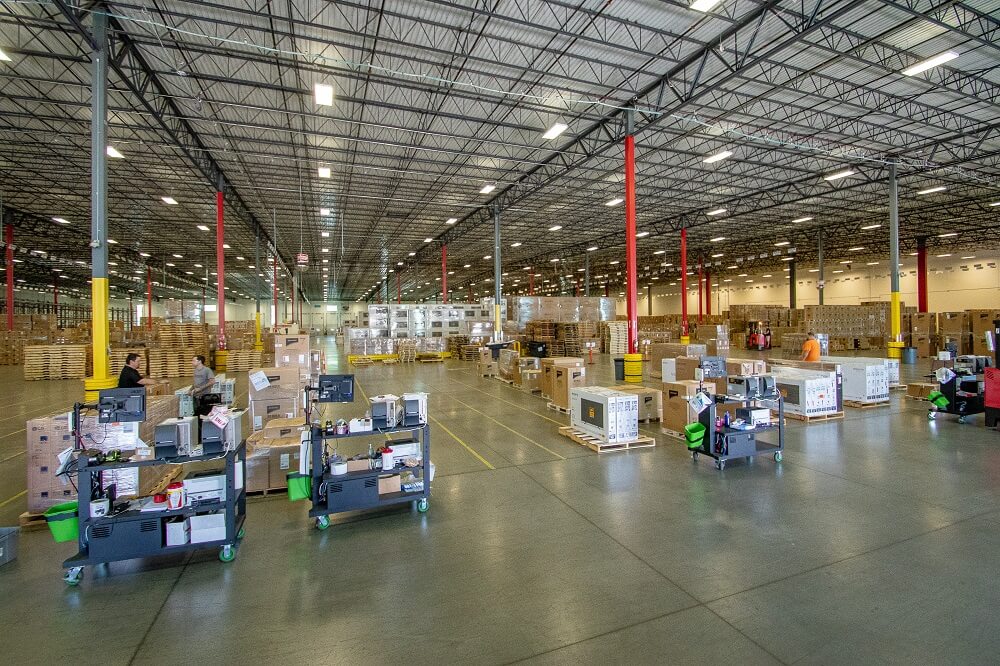With an influx of societal focus on the environment, individuals and organizations around the world are intensifying their efforts to foster sustainability, minimize their carbon footprints and actively participate in the circular economy. In fact, 55% of global companies have made specific and measurable circularity commitments, mostly around recycled inputs and waste reduction.
Although our current economic framework leans more toward a linear “take-make-waste” model of production and consumption, our society has a unique opportunity to propel the circular economy forward while economic, technological, and societal factors continue to align. And while circular principles have already proven their merit, our next hurdle — together as an industry and as individuals — is to scale these practices and transform them from niche strategies into collective norms.
First, How Does an Economy Work?
At its core, an economy seeks to address three fundamental questions:
- What needs to be produced?
- How do we produce it?
- Who benefits from the resulting goods and services?
Integral to these deliberations are the flows of materials, energy and information — including financial transactions — that constitute the backbone of any economic system. Governments and banks also play crucial roles in an economy, ensuring taxes and savings facilitate productive investments.
When left uninterrupted, an economy can reach societal equilibrium by balancing supply and demand and dictating the distribution of resources and services by market forces. This dynamic environment rewards innovation and efficiency and fosters growth and development for all parties involved. However, our traditional economic model often overlooks the environmental costs, leading to unsustainable resource exploitation, which is why many companies and individuals are investing time and resources into a more sustainable approach — the circular economy.
How Does the Circular Economy Work?
The circular economy thrives on the reuse and recycling of raw materials. Its essence lies in product design, which emphasizes durability, repairability and recyclability to minimize waste and emissions and focuses on what happens at the end of a product’s useful life. The economy operates on three pillars: reducing waste and pollution, maximizing resource reuse and enhancing ecosystem sustainability.
This model champions the idea of a regenerative system in which resources are used for as long as possible, extracting the maximum value and then recovering and regenerating products and materials at the end of each product life. It contrasts sharply with the “take-make-waste” mentality of the linear economy, aiming instead for a closed loop that virtually eliminates waste. This shift necessitates rethinking consumption patterns, urging separation from the disposability culture toward a more sustainable lifestyle that values longevity and sustainability over convenience and cost.
Moreover, the circular economy is not just about recycling materials; it's also about reimagining how businesses operate and engage with their customers. It encourages innovative business models like product-as-a-service, where consumers pay for the use of a product without owning it outright. This model not only prolongs the lifecycle of products but also aligns business success with sustainability goals, creating a win-win scenario for both the environment and the economy. In essence, the circular economy represents a systemic shift in how we produce, consume and think about resources, driving toward a future where economic growth is separate from environmental degradation.
How to Participate in the Circular Economy
Consumers and the Circular Economy
As the last rung in the circular economy, end users and consumers determine the fate of technology products that no longer meet their needs or expectations. Consider the devices you use daily; when they break down or underperform, often the most sustainable option is to explore manufacturer programs for trade-ins or recycling. For example, companies like Google, Apple and Dell (among many others) offer trade-in/trade-up programs for their devices, making it easy to turn in old equipment for store credit or upgrades. Even if your device doesn't qualify for an upgrade or credit, these companies often have policies to ensure responsible electronics recycling at no additional cost.
The benefits of engaging in the circular economy as a consumer extend beyond environmental preservation, too. In addition to the improved living conditions and associated health impacts of a greener environment, adopting circular economy practices could significantly increase the disposable income of households by reducing the costs of products and services. In the European Union, it's projected that the average household could see their disposable income increase by EUR 3000 by 2030.
Additionally, the circular economy promises excellent product utility and choice, effectively combating premature obsolescence and lowering total ownership costs. When manufacturers offer convenient recycling or trade-in programs, they empower consumers to participate in the circular economy effortlessly, enhancing both environmental sustainability and personal welfare.
Original Equipment Manufacturers and the Circular Economy
Original equipment manufacturers (OEMs) stand to guide the way toward a circular economy. OEMs can make significant strides toward circularity — and reap the benefits — by focusing on services integral to sustainability:
- Repair services are often a more cost-effective alternative to disposal. They extend the longevity of technology products, increase lifetime value, promote brand loyalty and allow for profitable recovery, reuse and recycling of products and parts to help minimize e-waste.
- Supply chain management services and logistics can positively contribute to ESG goals by reducing carbon emissions and optimizing packaging, inventory and transportation processes. Adhering to high standards for supply chain ethics is incredibly important, too.
- Field services help ensure proper deployment and installation so products are functioning optimally from the get-go. And ongoing maintenance and support from an authorized service provider helps retain product integrity and extends lifetime use.
- IT asset disposition services that use environmentally friendly practices and a closed-loop Environmental Management System (EMS) ensure compliance with data privacy laws, help customers reduce their technology waste production and maximize on potential financial returns from disposition.
Participating in the circular economy offers businesses many potential benefits, such as lower operational costs and new revenue streams. For example, leasing high-end washing machines could increase manufacturers' profits and their customer’s savings, and repurposing medical device components and raw materials through warranties and trade-in programs can add new revenue streams for medical device OEMs. Moreover, using more recycled materials reduces exposure to volatile raw material prices, enhancing supply chain security and resilience against external shocks.
The transition to a circular business model also fosters long-term customer relationships, increasing touchpoints and opportunities for engagement throughout the product lifecycle. These models offer insights into customer usage patterns, enabling continuous improvement in product design and service offerings and thereby enhancing customer satisfaction and loyalty.
However, it's crucial to recognize that OEMs' expertise primarily involves product development and production — not delivering expert repair services or handling end-to-end logistics operations that enable them to be part of the circular economy. Instead, outsourcing services like supply chain management, repair, refurbishment, deployment, maintenance, recycling and responsible disposal to a strategic, established partner who can fully integrate circular economy practices helps to optimize operational efficiencies, extend product lifecycles and garner long-term success in sustainability efforts.
What Does the Future of the Circular Economy Look Like?
If we stay on our current trajectory, the future of the circular economy — and our world — might begin to resemble the dystopian landscapes we've seen in movies. Instead of advancing sustainability and flourishing in a circular economy, we would find ourselves stuck in a cycle of increasing environmental degradation that relies on the “take-make-waste” model, with landfills overflowing. But a more hopeful path is achievable. In as few as five years, we can anticipate a transformative shift as OEMs worldwide prioritize sustainability and reinvent their approach to their product lifecycles, from design and material selection to end-of-life management.
Undoubtedly, it will take time, energy and research to figure out how to best repurpose recycled materials and which “greener” materials are well-suited for long-term product use over harmful ones, but it must be done — as we know, the environment can’t wait any longer. These pivotal design changes along with convenient sustainability programs for consumers hold promise to boost the circular economy and reduce our industry’s carbon footprint. Businesses must balance the extraction, usage and consumption of finite resources with effective supply chain management and reuse, repair and recycling initiatives. In doing so, we will build long-term resilience and foster a sustainable future together.
Companies are already responding by rethinking their business models, recognizing that small, immediate steps are vital for long-term sustainability. This includes actions like measuring a product's carbon footprint, inspired by traditional circular practices but tailored for today’s needs.
How Immediate Action Can Push the Circular Economy Forward
The path to reversing climate change is daunting. But it’s achievable with immediate, purposeful action. Our economy was essentially circular until the end of the 19th century — we've maintained this equilibrium before and can do so again by transitioning back to a circular model.
The shift back to a circular economy brings hope, urging a change in perspective toward more sustainable living. But collaboration and tailored approaches are imperative to long-term success. Sharing these lessons can lead to a significant, collective move toward circularity, addressing climate change and resource scarcity, especially in material-intensive sectors like healthcare. This shift not only rethinks product design but also integrates services and digital solutions for a more sustainable future.
As we stand at this pivotal juncture, we must all strive to recapture and maintain a harmonious balance between resource management and progress in order to effectively transition back to a circular economy that sustains our planet for generations to come. By closing the circle, we pave the way for a resilient and regenerative world.
For a deeper understanding of how to participate in this change as a technology company, explore insights and actions for a more sustainable future in the whitepaper “Your Guide to Actionable Sustainability in IT.”
About the Author
 Ron Brinckerhoff serves as Senior Vice President of Shyft Global Services. He is responsible for the strategic direction, global operations and oversight of Shyft, which provides outsourced technology management services for both the product and customer lifecycle to technology companies around the world. With more than 30 years of industry experience, Ron is a results-driven executive skilled at consistently building strong teams, growing sales, driving operational excellence and exceeding customer expectations.
Ron Brinckerhoff serves as Senior Vice President of Shyft Global Services. He is responsible for the strategic direction, global operations and oversight of Shyft, which provides outsourced technology management services for both the product and customer lifecycle to technology companies around the world. With more than 30 years of industry experience, Ron is a results-driven executive skilled at consistently building strong teams, growing sales, driving operational excellence and exceeding customer expectations.





